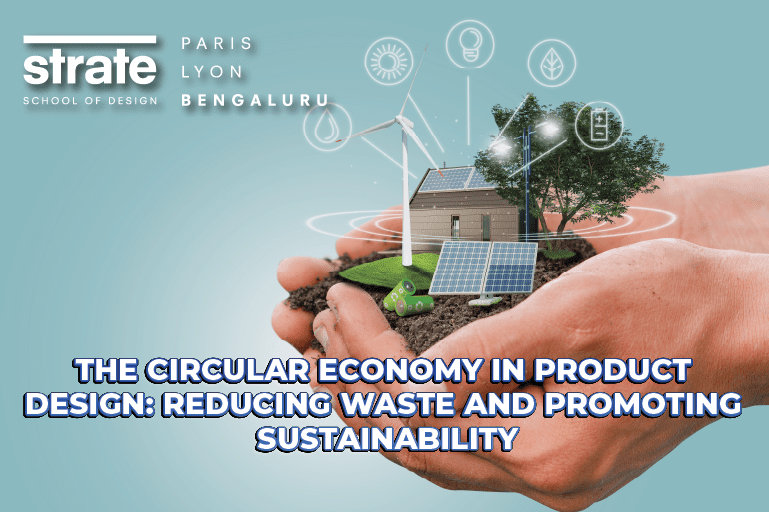Keep hearing about the circular economy and wonder what it means?
The modern human civilization has been practising the linear consumption model for so long, that grasping the concept of circular economy today appears to have become a task. In our daily lives, we take a product, use it, and throw it away. This process is called a linear economy model. The circular economy is when we stop waste from being produced. It is the practice that encourages each aspect of a product to be reused back in the design to production process, with a fundamental focus on waste elimination.
Circular Economy in Product Design
What does it mean when the circular economy is applied in the world of product design?
The main essence of this is to stop waste from being produced in the first place. Design and produce more effectively and efficiently keeping in mind the earth’s limited resources. When the circular economy concepts enter product design, the designers focus on:
a. humanity-centric approach to design and produce.
b. crafting solutions while keeping in mind the entire lifecycle of not just the final product but also the raw materials and their decomposition process.
Sustainable Product Design vs Circular Product Design
It’s vital to comprehend the difference between sustainable product design and circular economy-based product design. The major difference is that the former is the first step towards building a circular economy. Circular economy takes it many steps further:
– it takes into consideration the lifecycle of each material involved,
– it considers both present and future sustainability of the material and processes,
– it avoids one-time use of products, even if they are sustainable and fully recyclable.
– it builds a production and consumption cycle fuelled by recycling, repurposing, and conserving natural resources.
The practice of circular economy enables sustainability at every step of design and production.
How can Circular Design Help to Reduce Waste?
The Ellen Macarthur Foundation, one that is focused on building a circular economy, has stated in one of their publications that ‘The problem and the solution, start with design’.
They talk about how waste as a concept is a product of design and production cycles. A concept that otherwise does not exist in nature. Our modern world is packed with numerous plastic wrappers, chip packets, tetra packs, tall buildings, and tar roads – all designed without asking a few basic questions in the design process. The Ellen Macarthur Foundation put the main question: What happens to this at the end of its life?
This is where circularity in product design steps in to reduce waste. A designer must consider waste as a design flaw for practicing circular design. Aiming to hone their mind-set with the concept that each material must re-enter the economy at the end of its life cycle/use. For product designers, the process of design in the circular economy model is to think of:
1. Longevity and re-use
The design process must consider the long-term use of the product. The product should be able to sustain everyday wear and tear. The design itself should encourage users to re-use the product extending its lifespan. Take an example of refillable beauty containers that many global and Indian beauty brands are promoting today. You can simply take your empty moisturizer jar to the store and get it filled, rather than buying a brand-new jar, helping to reduce waste.
2. Durability and Maintenance
Along with lasting long-term, a designer must work on easy-to-repair and maintain product components. This helps consumers to recover the product in hand without discarding it as waste.
3. End of lifecycle/ disposal
This aspect is focused on efficient waste management and resource recovery systems. Designers must consider aspects like composting, recycling, and remanufacturing – all essential practices that help to capture valuable materials from waste streams. Helping to close the loop of minimizing waste.
How Can Circular Design Help to Promote Sustainability?
Circular design advocates for sustainable practices at each step of the process. It talks about designing with a mindset of zero waste production. In a circular economy, the designers work to establish sustainable production models. This means keeping track of raw materials, their lifecycle, and repeated use with minimum harm to the environment. Therefore, encouraging and promoting sustainability at each step of the process.
General product design cycle vs circular economy-based product design cycle
A general product designer’s work revolves around the cycle of ideation, research, prototyping, testing, iteration, development, and launch. And moving on to the next product with the same lifecycle. This turns the product life cycle into – a make, use, and throw model.
When designing with the circular economy in mind, the designers begin with a mindset of zero waste, minimal harm to the environment, and repeated use of the product in mind. This turns the product lifecycle into – design and production, use, reuse/ second life of the product with repair, maintenance, refurbishing, and recycling, bringing it back to the circular cycle of production.
Benefits of the Circular Economy in Product Design
1. Advocates sustainability
Product design can become a saviour for the growing consumption needs of our world. It can bring in sustainable yet engaging use of products for users with limited environmental resources running in the circularity loop.
2. Climate-positive approach
As our planet combats the climate change crisis, a circular design economy will help it sustain itself within already produced products. Reducing greenhouse gas emissions with cleaner production cycles. Longevity of use, reuse, and second life to products, extracting the maximum out of already produced products by recycling them. Using them again in the production process – these are all steps that help to combat climate change.
3. Reducing waste
One of the key benefits we cannot emphasize enough is waste reduction. When sustainability becomes a core strategy, zero-waste design solutions take the forefront. As Kate Krebs aptly quoted – ‘Waste is a design flaw’ and product designers stand at the forefront of building waste-free design solutions.
What Can Product Designers Learn from Indigenous Communities and Their Wisdom?
In many indigenous communities, craft clusters, and rural economies, the circular design economy is not an adaptation but a way of life. These communities connect to their local climate and environment to understand its patterns. They can mitigate environmental degradation with innovative and sustainable solutions.
A fine example of this is the rural practice of using terracotta clay to build homes in extremely hot locations in India. Many designers are now using this clay to build naturally cool architectural structures, no-electricity refrigerators, and more. Terracotta clay is easy to use, maintain and easily decompose in our soil. Ready for re-use, offering a fine example of how a circular design economy offers our planet a sustainable solution.



Want to Become a Designer ?
Strate is a unique design school that nurtures your talents as a designer by offering state-of-the art designing courses in Bangalore.
Join Strate